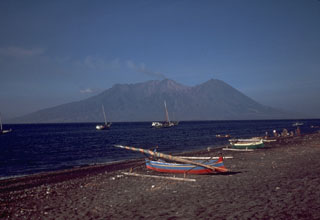Report on Sangeang Api (Indonesia) — July 1985
Scientific Event Alert Network Bulletin, vol. 10, no. 7 (July 1985)
Managing Editor: Lindsay McClelland.
Sangeang Api (Indonesia) Explosions eject tephra, lava flow; island evacuated
Please cite this report as:
Global Volcanism Program, 1985. Report on Sangeang Api (Indonesia) (McClelland, L., ed.). Scientific Event Alert Network Bulletin, 10:7. Smithsonian Institution. https://doi.org/10.5479/si.GVP.SEAN198507-264050
Sangeang Api
Indonesia
8.2°S, 119.07°E; summit elev. 1912 m
All times are local (unless otherwise noted)
"Sangeang Api . . . began to erupt on 30 July, with a series of explosions from the summit crater (Doro Api). The first explosion occured at about 0900 and produced a plume of tephra and gas to about 3,500 m altitude. Additional explosions occurred at 1130 (6,500 m), 1320 (6,500 m), and 1800 (1,500 m). Ashfall in Bima (50 km SW of the volcano), the capital of Sumbawa, totaled about 2 mm, and ashfall along the NE coast of Sumbawa, in the vicinity of the village of Wera, totaled about 2 cm. Between 30 July and 1 August, the 1,242 inhabitants of Sangeang Api island were evacuated to Sumbawa. Numerous additional Vulcanian explosions took place during the following week, reaching a maximum altitude of 2,500 m. Poor weather prevented systematic observations 1-5 August. On 6 August at 1939, a 0.7-km-long aa flow was observed advancing W from the region of Doro Api crater, toward the village of Doro Sangeang. By 9 August, the flow was 1.7 km long.
"The most recent eruption of Sangeang Api was in 1966; earlier eruptions occurred in 1512, 1715, 1821, 1860, 1911, 1912, 1927, 1953, [1954-1958 (six eruptions)], and 1964. Typical activity begins with strong Vulcanian explosions followed within a few days by Strombolian explosions. Eruptions in 1953 and 1964 ended with a lava flow and weak Strombolian explosions. Lavas from Sangeang Api are of basaltic composition (49-51% SiO2)."
Geological Summary. Sangeang Api volcano, one of the most active in the Lesser Sunda Islands, forms a small 13-km-wide island off the NE coast of Sumbawa Island. Two large trachybasaltic-to-tranchyandesitic volcanic cones, Doro Api and Doro Mantoi, were constructed in the center and on the eastern rim, respectively, of an older, largely obscured caldera. Flank vents occur on the south side of Doro Mantoi and near the northern coast. Intermittent eruptions have been recorded since 1512, most of them during in the 20th century.
Information Contacts: VSI.

